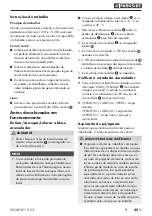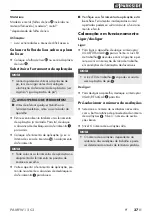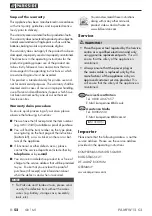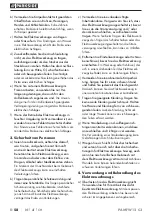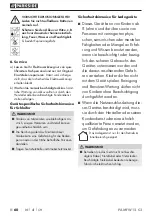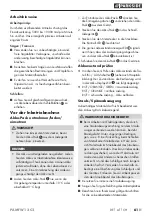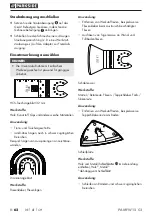
PAMFW 12 C3
GB
│
MT
│
49
■
1. To remove the battery pack , press the release
button and pull the battery pack out of the
appliance.
2. Insert the battery pack into the high-speed
charger .
3. Insert the mains plug into the socket. The control
LED lights up red.
4. The green charge status indicator LED indi-
cates that the charging process is complete and
the battery pack is ready.
5. Insert the battery pack into the appliance.
Checking the battery charge level
♦
Press the ON/OFF switch to check the status
of the battery (see also main diagram). The
status/remaining charge will be shown on the
battery display LED as follows:
♦
RED/ORANGE/GREEN = maximum charge
RED/ORANGE = medium charge
RED = low charge – charge the battery
Dust/chip extraction
Materials containing asbestos may not be pro-
cessed. Asbestos is a known carcinogen.
WARNING! RISK OF FIRE!
■
When working with electrical appliances that
can be connected to a vacuum cleaner via a
vacuum cleaner adapter, there is a risk of fire!
In unfavourable conditions, e.g. when sparks
are flying while sanding metal or metal
residues in wood, wood dust in the bag of
the vacuum cleaner can spontaneously ignite.
This is a particular risk if the wood dust is
mixed with paint residues or other chemicals
and the workpiece has become hot after be-
ing worked for a long time. Therefore, avoid
overheating of the material being sanded as
well as the appliance. Always empty the
vacuum cleaner’s dust bag before taking
work breaks.
■
Always use dust extraction.
■
Ensure that your workplace is adequately
ventilated.
■
Observe the regulations applicable in your
country regarding the materials to be worked.
Connecting a dust extraction appliance
♦
Push the dust extraction unit onto the appli-
ance. Fix it in place by fitting the housing attach-
ment .
♦
Push the hose from a suitable dust extraction ap-
pliance (e.g. a workshop vacuum cleaner) onto
the adapter for external vacuum extraction.
Select a tool
NOTE
►
The universal fitting without-tool-change is
suitable for standard accessories.
HCS plunge saw blade 32 mm
Materials:
Wood, plastic, gypsum (plaster) and other soft
materials
Application:
–
separation and plunge saw cuts
–
sawing close to edges, even in hard to reach
areas
Example: sawing of recesses in lightweight walls.
Diamond saw blade
Materials:
Tile adhesives, tile joints
HCS
Z64
B2
Summary of Contents for PARKSIDE PAMFW 12 C3
Page 3: ...Z52 A1 Z64 B2 HCS C...
Page 32: ...PAMFW 12 C3 28 IT MT...

